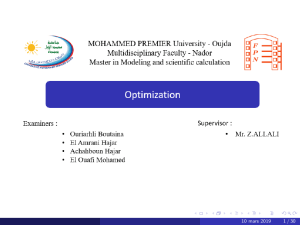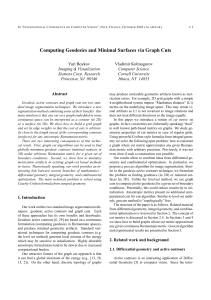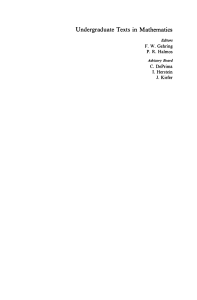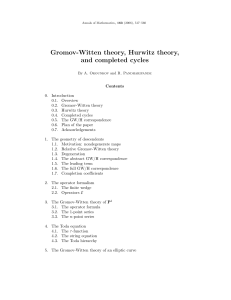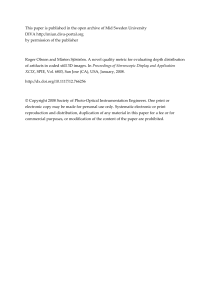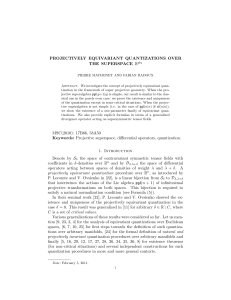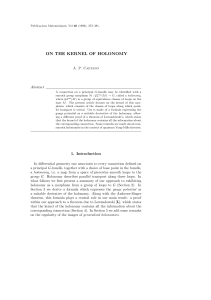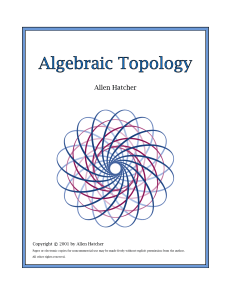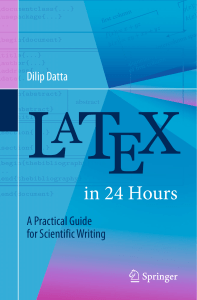02141493v45n1p223
publicité
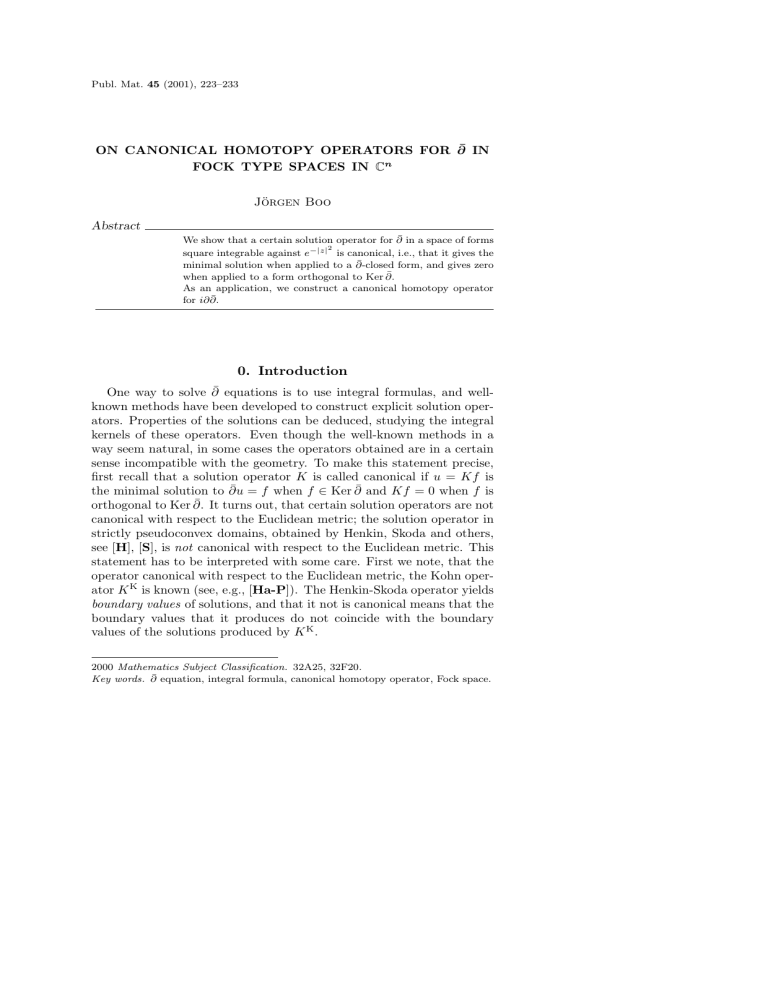
Publ. Mat. 45 (2001), 223–233
ON CANONICAL HOMOTOPY OPERATORS FOR ∂¯ IN
FOCK TYPE SPACES IN Cn
Jörgen Boo
Abstract
We show that a certain solution operator for ∂¯ in a space of forms
2
square integrable against e−|z| is canonical, i.e., that it gives the
¯
minimal solution when applied to a ∂-closed
form, and gives zero
¯
when applied to a form orthogonal to Ker ∂.
As an application, we construct a canonical homotopy operator
¯
for i∂ ∂.
0. Introduction
One way to solve ∂¯ equations is to use integral formulas, and wellknown methods have been developed to construct explicit solution operators. Properties of the solutions can be deduced, studying the integral
kernels of these operators. Even though the well-known methods in a
way seem natural, in some cases the operators obtained are in a certain
sense incompatible with the geometry. To make this statement precise,
first recall that a solution operator K is called canonical if u = Kf is
¯ = f when f ∈ Ker ∂¯ and Kf = 0 when f is
the minimal solution to ∂u
¯ It turns out, that certain solution operators are not
orthogonal to Ker ∂.
canonical with respect to the Euclidean metric; the solution operator in
strictly pseudoconvex domains, obtained by Henkin, Skoda and others,
see [H], [S], is not canonical with respect to the Euclidean metric. This
statement has to be interpreted with some care. First we note, that the
operator canonical with respect to the Euclidean metric, the Kohn operator K K is known (see, e.g., [Ha-P]). The Henkin-Skoda operator yields
boundary values of solutions, and that it not is canonical means that the
boundary values that it produces do not coincide with the boundary
values of the solutions produced by K K .
2000 Mathematics Subject Classification. 32A25, 32F20.
Key words. ∂¯ equation, integral formula, canonical homotopy operator, Fock space.
224
J. Boo
In [ABO], we studied canonical solution operators in strictly pseudoconvex domains. One major result was that, in the special case of the
ball, the Henkin-Skoda operator is canonical with respect to the metric Ω = i (−ρ) ∂ ∂¯ log (1/ − ρ), where −ρ is the distance to the boundary.
This means that the values given by the Henkin-Skoda operator coincide
with the boundary values given by the canonical operator.
There were additional advantages of using the non-Kähler metric Ω
instead of the Euclidean metric, for example the domain of the formal
adjoint operator ∂¯∗ contains all forms that are smooth up to the boundary, contrary to the Euclidean case. This suggests that the Ω metric in
some sense is more natural than the Euclidean metric. (The metric Ω is
also related to the natural metric on the boundary.)
In a general strictly pseudoconvex domain, the Henkin-Skoda operator
is only approximately canonical with respect to Ω in a certain sense,
see [A-Boo].
In this paper, we study a space of forms in all of Cn with growth of infinite order. Using a technique described in [A-Be], a solution operator
is obtained. The main result of this paper is that the solution operator
is canonical with respect to the Euclidean metric. As an application, following the lines in [ABO], we construct a canonical homotopy operator
¯
for i∂ ∂.
The paper is organized like this: In Section 1 we construct the solution operator, and in Section 2 the operator is expressed in terms of
the metric, and we can see that the operator is canonical. Finally, in
Section 3, we obtain some simple regularity results and construct a ho¯
motopy operator for i∂ ∂.
1. Construction of the operator
¯ The
In this section, we construct a homotopy operator K for ∂.
operator is essentially well known even in a much more general setting,
see for instance [A-Be], but nevertheless we sketch the construction in
our case.
We start with a general process of constructing homotopy operators.
n
n
n
Let η = ζ − z. Let Q and S be mappings
from C × C to C . Define
forms q and s by q = Qj dηj and s = Sj dηj . For t ≥ 0 we let
n
Pt (ζ, z) = Cn e(Q+tS)·η (d (q + ts)) ,
Homotopy Operators for ∂¯ in Fock Space
225
where
Cn−1 = (−1) n! (2πi) , and S · η is defined by S · η (ζ, z) =
Sj (ζ, z) ηj (ζ, z), and so on. Define the kernel K by
∞
K (ζ, z) =
Pt (ζ, z) .
n
n
t=0
n
n−1
∧
Note that d (q+ts) = dq+tds−s∧dt, so (d (q+ts)) = A−n (dq + tds)
s ∧ dt, where A contains no differentials with respect to t. Hence
∞
n−1
K (ζ, z) = −Cn n
e(Q+tS)·η s ∧ (dq + tds)
dt.
0
Put
Ik (ζ, z)
∞
k+1
= Cn
(−1)
0
n−k−1
n!
s ∧ (dq + tds)
e(Q+tS)·η
k
(n − k − 1)!
(S · η)
k
∧ (ds)
dt
and
n−k
k+1
Tk (ζ, z) = Cn (−1)
k−1
n!
s ∧ (dq)
∧ (ds)
eQ·η
k
(n − k)!
(S · η)
.
By formally integrating by parts, we see that if 1 ≤ k ≤ n − 1, then
K (ζ, z) = T1 (ζ, z) + · · · + Tk (ζ, z) + Ik (ζ, z). If we note that In−1 = Tn ,
we get the formula
n
K (ζ, z) =
Tk (ζ, z) .
k=1
Change the summation variable and, to let the operator fit into our
situation, choose Q (ζ, z) = −ζ̄ and S (ζ, z) = η̄. Then:
(1.1) K (ζ, z) = Cn
×
n−1
k=0
n! z·ζ̄−|ζ|2
e
k!
k n−k−1
ζ̄ − z̄ · (dζ − dz) ∧ (dζ − dz) · dζ̄ ∧ (dζ − dz) · dζ̄ − dz̄
2n−2k
|ζ − z|
.
The kernel K is of total bidegree (n, n − 1). Denote by Kq the component
of K which is of bidegree (0, q) in z, and hence (n, n − q − 1) in ζ. We
find Kq by expanding
n−k−1
dζ · dζ̄ − dz̄
n−k−1
n − k − 1 n−k−q−1
q
dζ · dζ̄
=
∧ (−dζ · dz̄) .
q
q=0
226
J. Boo
This gives the formula
Kq (ζ, z) = Cn
n−q−1
k=0
2
n! n − k − 1
q
(−1) ez·ζ̄−|ζ|
k!
q
n−q−1
q
ζ̄ − z̄ · dζ ∧ dζ · dζ̄
∧ (dζ · dz̄)
×
.
2n−2k
|ζ − z|
(In this formula, k only occurs in the constant and in the exponent of
the denominator.) Change the definition of K by letting K (ζ, z) =
n−1
q=0 Kq (ζ, z). This is motivated by the fact that we will integrate K
against (0, q)-forms in ζ; we simply ignore the irrelevant parts of K.
The leading term in K (ζ, z), corresponding to k = 0, equals φ (ζ, z) =
e
times the Bochner-Martinelli kernel B (ζ, z), and K (ζ, z) =
¯ are inteφ (ζ, z) B (ζ, z) + K (ζ, z), where the kernel K as well as ∂K
¯
grable. It is well known that ∂B (ζ, z) = [∆], where ∆ = {ζ = z} is the
diagonal and [∆] denotes the current of integration over ∆. Thus (since
φ (z, z) = 1 and ∂¯z φ (ζ, z) = 0)
z·ζ̄−|ζ|2
¯ (ζ, z) = ∂¯ζ φ (ζ, z) ∧ B (ζ, z) + ∂K
¯ (ζ, z) + [∆] .
∂K
Let A = n (dq + tds)
∧s, so that Pt = Cn φA−Cn φA ∧dt = a−a ∧dt
n
(with A = (dq + tds) as before). Then, since Pt is a closed form,
0 = dPt = da − dζ,z a ∧ dt and hence the formula
∞
∞
¯ = dK =
∂K
dζ,z a dt =
da
n−1
t=0
0
n
= −a|t=0 = −Cn φ (ζ, z) (dq) = −P0 (ζ, z)
n
¯ .)
is valid off the diagonal. (Also note that P0 (ζ, z) = Cn φ (ζ, z) ∂q
¯ = [∆] − P0 .
By this we will have that ∂K
Let K and P also denote
the operators associated to the kernels K(ζ, z)
and P0 (ζ, z); Kf (z) = K (ζ, z) ∧ f (ζ) and similarily for P . Since the
kernel K is a form of total degree 2n − 1, we will have that
¯
¯
¯
¯ (ζ)
∂Kf = ∂ K (ζ, z) ∧ f (ζ) = ∂K (ζ, z) ∧ f (ζ) − K (ζ, z) ∧ ∂f
¯
¯ = [∆] .f − P f − K ∂f
¯ = f − P f − K ∂f.
¯
= ∂K.f
− K ∂f
Thus we have obtained the homotopy formula
(1.2)
¯ + K ∂¯ = I − P,
∂K
Homotopy Operators for ∂¯ in Fock Space
227
that a priori is valid only for, say, C 1 -forms with compact support, but
as we will see in Section 2, by completeness (1.2) stays valid for all forms
2
square integrable against e−|z| .
2. Expressing the operator in the metric
2
Let β = i∂ ∂¯ |z| /2. Denote by ·, · the pointwise Euclidean metric
(for forms) generated by β, and let βk = β k /k!. The Lebesgue volume
form equals the form dV = βn . If f and g are (0, q)-forms, then
(2.1)
f, g dV = cq f ∧ ḡ ∧ βn−q ,
where the constant cq equals 1 if q is even and −i if q is odd. Further,
we have that dζ · dζ̄ = −2iβ.
Let L2q be the set of all (0, q)-forms with finite norm with respect to
the metric
(f, g) = c
e−|z| f, g dV,
2
where c = π −n , which gives the constant function 1 norm 1. Let Kq =
¯ in particular K0 = F 2 is the Fock space of entire functions,
L2q ∩ Ker ∂;
2
square integrable against e|z| .
The operator
K can be expressed as inner multiplication by the kernel k (ζ, z) = q kq (ζ, z), where
n−q−1
q
z·ζ̄ ζ̄ − z̄ · dζ ∧ (dζ · dz̄)
kq (ζ, z) =
Cn,q,k e
2n−2k
|ζ − z|
k=0
and
Cn,q,k
Cn n! n − k − 1
n−1 n−q−1 n−q−1
(−1)
=
2
i
(n − q − 1)!
cq+1 k!
q
n−1
=
(−1)
(n − k − 1)! (n − q − 1)!
,
q+1
n
q+1
2 π i cq+1 k! (n − k − q − 1)!q!
i.e. Kf (z) = f, k (·, z) . (Note, that the constant Cn,q,k is real.)
Proposition 2.1. The operator K is L2 -bounded.
Proof: We have the estimate
|k (ζ, z)| eRe z·ζ̄
2n−1
|ζ − z|
228
J. Boo
for the kernel. Use the Cauchy-Schwarz inequality to obtain
2
Kf =
2
2
2 e−|z| f, k̄ dV (z)
2
2
− |ζ−z|2 − Re z·ζ̄ − |ζ|2 e
2
=
e
e 2 f (ζ) , k (ζ, z) dV (ζ) dV (z)
≤ I1 (z) I2 (z) dV (z) ,
where
e−
I1 (z) =
|ζ−z|2
2
2n−1 dV
|ζ − z|
(ζ) = C < ∞
and
I2 (z) =
≤
e−
e−
e−
|ζ−z|2
2
|ζ−z|2
2
|ζ−z|2
2
2n−1 −2 Re z·ζ̄ −|ζ|2
2
f (ζ) , k (ζ, z) dV (ζ)
2n−1 −2 Re z·ζ̄ −|ζ|2
|f (ζ)| |k (ζ, z)| dV (ζ)
|ζ − z|
e
|ζ − z|
e
e
e−|ζ| |f (ζ)|
2
e
1
2
2n−1 dV
|ζ − z|
2
2
(ζ) .
Hence
2
Kf −|ζ|2
e
2
|f (ζ)|
e−
|ζ−z|2
2
2n−1 dV
|ζ − z|
2
(z) dV (ζ) f .
Remark 1. In [A-Boo], we make extensive use of the fact that a certain
homotopy operator is compact. In this situation, however, the operator K is not compact. This can be seen as follows.
Consider one complex variable. The set of all
zk
fk = √ dz̄
k!
is an orthonormal set in K1 . Let uk = Kfk . Since the functions
2
|z| − k k−1
√
z
k!
also constitute an orthonormal set, we have an example of a bounded
sequence (fk ) such that the image sequence (Kfk ) has no convergent
subsequence. Hence K is not compact on L2 .
uk =
Homotopy Operators for ∂¯ in Fock Space
229
By considering the kernel of the operator P defined in Section 1, P is
easily seen to be the orthogonal projection from L20 onto F 2 .
Since Cn equipped with the β-metric is a complete manifold, the
smooth, compactly supported forms are dense in the graph norms (see
e.g. [B]). We already know that the homotopy formula (1.2) is valid for
smooth, compactly supported forms, hence the formula is valid for all
¯
forms in Dom ∂.
Remark 2. The L2 -boundedness of K helps to explain why (1.2) is valid
¯ in the following way: If f is in the domain of ∂,
¯ and
for all f ∈ Dom ∂,
¯ all are
in particular f itself is in L2 , then the terms f , P f and K ∂f
in L2 . By approximation with smooth, compactly supported forms, we
¯
see that ∂Kf
is in L2 as well and that (1.2) stays valid in the limit. In
¯ and that
particular, we conclude, that Kf ∈ Dom ∂¯ for all f ∈ Dom ∂,
¯ : Dom ∂¯ → K is a projection.
∂K
It is easily checked that k (ζ, z) = ∂ζ h (ζ, z), where
n−1
h (ζ, z) = q=0 hq (ζ, z),
hq (ζ, z) =
n−q−1
k=0
q
−
Cn,q,k z·ζ̄ (dζ · dz̄)
e
2n−2k−2
n−k−1
|ζ − z|
for q > 0 and
h0 (ζ, z) =
n−2
−
k=0
Cn,0,k
ez·ζ̄
2
+ Cn,0,n−1 ez·ζ̄ log |ζ − z| .
·
n − k − 1 |ζ − z|2n−2k−2
q
Since h is hermitean,
i.e. hq (z,
ζ) = (−1) hq (ζ, z), the operator H defined by Hf (z) = f, h (·, z) is self-adjoint. Thus we have seen that
K = H ∂¯∗ , where ∂¯∗ is the formal adjoint of ∂¯ with respect to (·, ·).
¯ is selfadjoint, and hence
As an immediate consequence, we get that ∂K
is the orthogonal projection onto K. Thus the homotopy formula (1.2)
gives the orthogonal decomposition L2 = K ⊕ K⊥ .
Remark 3. By the method in the proof of Proposition 2.1, one can see
that the operator H is bounded on L2 .
Remark 4. By the Kähler identities for vector bundles (see for instan2
ce [B]), ∂¯∗ = i [∂, β¬] + ∂ |z| ¬ = 12 [∂, dz̄ · dz¬] + z̄ · dz¬, where the
brackets denote the commutator and ¬ denotes interior multiplication
with respect to β. When we, as in this context, only let ∂¯∗ act on
(0, q)-forms, this expression reduces to ∂¯∗ = z̄ · dz¬ − 12 dz̄ · dz¬∂.
We conclude:
230
J. Boo
Theorem 2.2. K is the canonical operator with respect to (·, ·).
¯ then ∂¯∗ f = 0, so Kf = 0. If, on
Proof: If f is orthogonal to Ker ∂,
¯
¯ , so Kf = K ∂Kf
¯
the other hand, ∂f = 0, then f = ∂Kf
= Kf −
¯
¯
¯
∂KKf , and hence ∂K (Kf ) = 0. Since ∂K is the orthogonal projection
onto the kernel, Kf is orthogonal to the kernel, and hence the minimal
solution.
3. Application to solving i∂ ∂¯ problems
Note, that the kernel K (ζ, z) from (1.1) almost is a convolution kernel; K (ζ, z) = φ (ζ, z − ζ) A (z − ζ), where φ (ζ, z) = ez·ζ̄ and A (η) is an
∗
(integrable) convolution kernel whose coefficients roughly are η̄k / |η| ,
where ∗ denotes an exponent not higher than 2n. By performing an
appropriate change of variables in the integral defining Kf and differentiating under the integral sign, and then substituting back, we see
that Kf has partial derivatives with respect to zk and z̄k if f has, and
furthermore K commutes with the holomorphic derivatives in the sense
that
∂
∂f
(3.1)
Kf = K
∂zk
∂ζk
(where we let the derivative act as a Lie derivative on forms, i.e. so that
it only affects the coefficient functions). As a consequence, we have that
K preserves regularity. By similar arguments, P preserves regularity
and satisfies the same commuting rule (3.1) as K. In particular, the
homotopy formula (1.2) gives a C ∞ -smooth orthogonal decomposition
of L2 ∩ C ∞ .
Remark 5. For antiholomorphic derivatives, there is no rule as simple as
(3.1). Instead, we have the formula
∂
∂f
Kf = K
+ zk Kf − K (ζk f ) .
∂ z̄k
∂ ζ̄k
However, the main reason for using (3.1) is to prove Proposition 3.1
below. The corresponding commutation rule for ∂¯ would be hard to
prove using the above formula for the antiholomorphic derivatives, and
anyway the rule for ∂¯ is known; it is just the homotopy formula (1.2).
Recall that we restricted the operator K to operate on (0, q)-forms
only. Now we extend K to an operator operating on (p, q)-forms by
demanding
that the
be ignored; more precisely we let
(p, 0)
part should
K aI,J¯dζ̄ J ∧ dζ I = K aI,J¯dζ̄ J ∧ dz I . The homotopy formula (1.2)
and the commutation rule (3.1) still hold for this extended K. If Φ(ζ, z) =
Homotopy Operators for ∂¯ in Fock Space
231
dz I ∧dζ̄ I , then the kernel for this extended K is k (ζ, z)∧Φ (ζ, z), and
thus the kernel for the corresponding operator H such that K = H ∂¯∗ is
h (ζ, z) ∧ Φ (ζ, z). In particular, H is self-adjoint, which in turn implies
¯ acting on (p, q)-forms, is the orthogonal projection
that the operator ∂K,
¯
onto the kernel of ∂.
The observation above concerning holomorphic derivatives yields the
following proposition.
I
Proposition 3.1. ∂K = −K∂ and ∂P = P ∂.
q ∂
Proof: If f is a q-form, then ∂f = (−1)
∂zk f ∧ dzk . Thus
∂K αdζ̄ J ∧ dζ I = ∂K αdζ̄ J ∧ dz I
∂
K αdζ̄ J ∧ dzk ∧ dz I
∂zk
∂α J
|J|−1
∧ dzk ∧ dz I
K
= (−1)
dζ̄
∂ζk
∂α J
|J|−1
= (−1)
K
dζ̄ ∧ dζk ∧ dζ I
∂ζk
= −K ∂ αdζ̄ J ∧ dζ I .
|J|−1
= (−1)
That proves the statement for K, and by using (1.2) twice we get that
¯ = ∂f + K∂ ∂f
¯ = ∂f − K ∂∂f
¯ = P ∂f,
∂P f = ∂ f − K ∂f
which proves the statement for P .
Remark 6. This proposition and the homotopy formula (1.2) gives the
corresponding homotopy formula dK + Kd = I − P for d.
In addition, we define operators K̄ and P̄ by K̄f = K f¯ and analogously for P̄ . The operator K̄ obviously takes (p + 1, q)-forms into
(p, q)-forms. Note that the operator K K̄ solves the ∂ ∂¯ equation: If f is
¯
a d-closed (q, q)-form, then f is both ∂- and ∂-closed.
Hence v = K̄f
¯
satisfies ∂v = f and (by Proposition 3.1) ∂v = 0. Let u = Kv. Then
¯ = v, hence ∂ ∂K
¯ K̄f = ∂ ∂u
¯ = ∂v = f . Thus, we can easily find an
∂u
¯
operator that solves ∂ ∂ equations. However, to get a homotopy operator, we need a little extra effort. (Also note, that the solutions were
minimal in each step, but that the resulting solution will not necessarily
be minimal.)
232
J. Boo
Definition 1. Define operators M, D and Π acting on smooth
(q, q)¯ + ∂K∂
¯ K̄ if q > 0,
forms by: Let M = 2i K̄K − K K̄ , D = 12 ∂ K̄ ∂K
¯ + ∂ K̄ − D if q > 0 and
and D = P P̄ on functions. Finally, let Π = ∂K
Π = P + P̄ − D on functions.
Note that M lowers the degree by (1, 1), while D and Π preserve
degrees. All three operators map real forms to real forms. Some geometrical interpretations of these operators are listed in the following
theorem.
Theorem 3.2. Consider D, Π and M as operators between L2 -spaces
of smooth (q, q)-forms.
1. D is the orthogonal projection onto Ker d.
¯
2. Π is the orthogonal projection onto Ker i∂ ∂.
3. M is a canonical homotopy operator for i∂ ∂¯ in the sense that
¯ = u − Πu
M i∂ ∂u
and
¯ u = Du.
i∂ ∂M
Proof: We begin with a proof of part 3 concerning M . Since, for q ≥ 2,
¯ = K ∂¯K̄∂ = I − ∂K
¯
K K̄∂ ∂¯ = −K K̄ ∂∂
I − ∂ K̄
¯ + ∂K∂
¯ K̄
= I − ∂ K̄ − ∂K
¯ = I − ∂K
¯ − ∂ K̄ + ∂ K̄ ∂K,
¯ we have that
and in the same way K̄K ∂∂
1
¯ = I + 1 ∂K∂
¯ K̄ + ∂ K̄ ∂K
¯
¯
K K̄∂ ∂¯ + K̄K ∂∂
− ∂ K̄ + ∂K
,
2
2
which is the first assertion of 3 for q ≥ 1; the case q = 0 is handled in the
same way. The second assertion of 3 is immediate from the definitions
and Proposition 3.1.
¯ =0
Part 1 follows from the observation that if du = 0, then ∂u = ∂u
and hence
¯
−∂ ∂¯K̄Ku = ∂ K̄ ∂Ku
= ∂ K̄ I − K ∂¯ u = ∂ K̄u = u − K̄∂u = u;
¯ K̄u = u, and the claim that D is a projection is
in a similar way ∂ ∂K
proved (dD = 0). That it is orthogonal follows because it is self-adjoint.
That Π is a projection onto Ker i∂ ∂¯ is obvious from part 3, and it
follows immediately that it in fact is the orthogonal projection.
Homotopy Operators for ∂¯ in Fock Space
233
References
[A-Boo] M. Andersson and J. Boo, Approximate formulas for canonical homotopy operators for the ∂¯ complex in strictly pseudoconvex domains, Math. Scand. (to appear).
[ABO] M. Andersson, J. Boo and J. Ortega-Cerdà, Canonical
homotopy operators for the ∂ complex in strictly pseudoconvex
domains, Bull. Soc. Math. France 126(2) (1998), 245–271.
[A-Be] B. Berndtsson and M. Andersson, Henkin-Ramirez formulas with weight factors, Ann. Inst. Fourier (Grenoble) 32(3)
(1982), 91–110.
[B]
B. Berndtsson, “L2 -methods for the ∂¯ equation”, KASS Univ.
Press, Göteborg, 1995.
¯
[Ha-P] F. R. Harvey and J. C. Polking, The ∂-Neumann
solution
to the inhomogeneous Cauchy-Riemann equation in the ball in
Cn , Trans. Amer. Math. Soc. 281(2) (1984), 587–613.
[H]
G. M. Henkin, Solutions with bounds for the equations of
H. Lewy and Poincaré-Lelong. Construction of functions of
Nevanlinna class with given zeros in a strongly pseudoconvex
domain, Dokl. Akad. Nauk SSSR 224(4) (1975), 771–774.
[S]
H. Skoda, Valeurs au bord pour les solutions de l’opérateur
d , et caractérisation des zéros des fonctions de la classe de
Nevanlinna, Bull. Soc. Math. France 104(3) (1976), 225–299.
Department of Physics and Mathematics
Mid-Sweden University
S-851 70 Sundsvall
Sweden
E-mail address: [email protected]
Rebut el 8 de setembre de 2000.
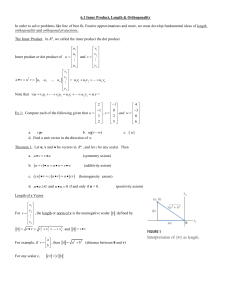

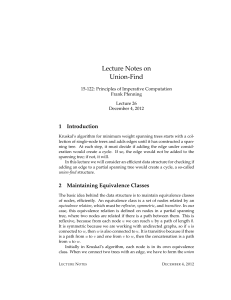
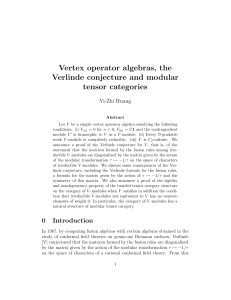
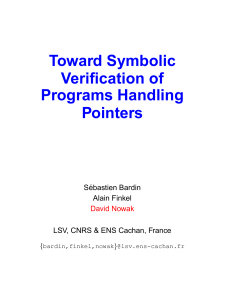
![[arxiv.org]](http://s1.studylibfr.com/store/data/008896207_1-63eedad65772237bdb43b0718aaf3bcb-300x300.png)
